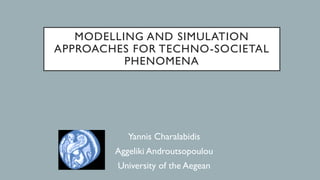
Modelling and Simulation Approaches for Techno-Societal Phenomena
- 1. MODELLING AND SIMULATION APPROACHES FOR TECHNO-SOCIETAL PHENOMENA Yannis Charalabidis Aggeliki Androutsopoulou University of the Aegean
- 2. “We lack systematic evidence as to whether social science studies of policy interventions, and steps to increase their relevance to and use for policy making, are having the results their sponsors hope for. . . .” [Knowledge and Policy:The Uncertain Connection, 1978, National Research Council, U.S.]
- 3. Financial Crisis Poverty Unemployment System risk Sustainability Climate change Energy sufficiency Shortage of natural resources Crisis Management (Floods, Earthquakes) Pollution Urbanization Pandemics (virus, physical diseases) Ageing population Migration patterns Cities Crime Terrorism GLOBAL SOCIETAL CHALLENGES Social EnvironmentalEconomic
- 4. GLOBAL SYSTEM SCIENCE ① identify problems and challenges for societies ② measure their magnitude and seriousness ③ review alternative policy interventions ④ systematically assess the consequences of policy interventions ⑤ evaluate the policy results, using factual information
- 5. MODELLING OBJECTIVES • Reduce the uncertainty of complex heterogeneous techno- societal phenomena • Prediction of social indicators, demographics, assessment of socio-economic impacts • Formalisation of processes/mechanisms/behaviours • Collect evidence for effective transparent decision making • Provision of a holistic view of our connected world
- 6. MODELLING APPROACHES High Abstraction Less Details Macro Level Middle Abstraction Medium Details Meso Level Low Abstraction More Details Micro Level Individual objects, exact sizes, distances, velocities, timings, … Agent Based Active objects Individual behavior rules Direct or indirect interaction Environment models Discrete Event Entities (passive objects) Flowcharts and/or transport networks Resources Aggregates, Global Casual Dependencies, Feedback Dynamics, … System Dynamics Levels (aggregates) Stock-and-Flow Diagrams Feedback loops Dynamic System • Physical state variables • Block diagrams and/or algebraic- differential equations ContinuousDiscrete System- Level Process- Centric Individual- Centric
- 7. EXAMPLE: THE ICT DIFFUSSION MODEL (modelling and prediction of citizens acquiring broadband access) broadband coverage projects broadband coveragecoverage rate broadband users potential internet users broadband take up rate TECHNOLOGY FACTOR cost of access internet access at homeaccess rate internet users usage rate digitally skilled peopleliteracy rate need to use physical disabilities perception of benefits fear about safety LITERACY FACTOR training e-awareness non internet users potential coverage digitally illiterate peoplepotential internet access access points COVERAGE CAGR availability of access points Private investment non broadband usersnon bb(pstn) takeup rate <Time>
- 8. EXAMPLE: FORECASTING PARTICIPATION IN ONLINE POLICY DELIBERATION
- 9. MODELLING CHALLENGES • Interventions in one area often have implications on other domains through subtle, and hidden connectivity • Hard to construct models of adequate depth to cover complex interlinked societal challenges • Hard to capture behavioral aspects and can have unprecedented effects
- 10. A PROPOSITION ON A HOLISTIC MODELLING APPROACH • A Hybrid Collaborative Modelling approach supported by a web platform for: • Reuse and combination of different interoperable models and model types • Effective data handling and integration of multiple sources • Capturing and processing of societal factors, together with widely adopted socio-economic indicators • Supporting advanced modelling techniques state of the art dynamic simulation approaches • Combination with social behavior factors, social participation and crowdsourcing initiatives
- 11. ARCHITECTURE OF A HYBRID MODELLING AND SIMULATION PLATFORM
- 12. PLATFORM FUNCTIONALITIES • Storage and retrieval of different types of interoperable models • Easy to use graphical interface for the design of simulation models by non modelling experts • Online workspace for asynchronous collaboration or during Group Model Building sessions • Import and Export capabilities of models in machine readable formats (e.g. XMILE) • Visualisation and export of simulation results e.g. graphs or standardised result files that can be processed by third party tools. • API exposure to third party applications
- 13. PLATFORM PRINCIPLES • Usability • Scalability • Adaptability • Interoperability (with existing systems and infrastructures) • Sustainability • Platform independence • Maintenance of the system (modifications and upgrades)
- 14. KEY ISSUES – THE PROCESS • Study phenomena • Define Models (find the main qualities and indicators) • Describe Models in machine-understandable format • Combine and reuse models and algorithms • Find Enough Data for model instantiation • Provide computation power to run and maintain • Simulate • Produce analytics • Forecast • Create narratives
- 15. CONCLUSIONS • There is a need for (big) data-based social phenomena modelling, towards understanding and forecasting behavior • Several methods and tools of modelling and simulation exist, not interoperable to each other and rather “passive” • New platforms for modelling and simulation need to • support knowledge bases with models for different phenomena, • combine macro-micro simulation • allow for interoperable combination of different models • cater for the dynamic input of citizens (probing) • If we succeed in modelling, we might start prognosing social phenomena or even find the right solutions to societal challenges
- 16. Yannis Charalabidis Associate Professor Head, Information Systems Laboratory Department of Information and Communication Systems Engineering University of The Aegean yannisx@aegean.gr www.charalabidis.gr @yannisc
